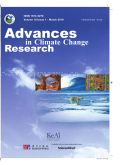- 钛学术文献服务平台 \
- 学术期刊 \
- 基础科学期刊 \
- 天文学、地球科学期刊 \
- 气候变化研究进展(英文版)期刊 \
The policy-driven peak and reduction of China's carbon emissions
The policy-driven peak and reduction of China's carbon emissions
基本信息来源于合作网站,原文需代理用户跳转至来源网站获取
摘要:
Pursuant to the Paris Agreement,China committed itself to peak its carbon emissions by around 2030 and to increase the non-fossil share of primary energy to 20% at the same time.The government has supported the international agreement by setting and strengthening the domestic policy targets for an earlier peak and faster reduction,aiming to contain the average global temperature increase to well below 2 ℃.We develop a Kaya Inequality method to assess the time of peak and pace of reduction of China's energy-related CO2 emissions based on the national energy policy targets for 2030.We find that,despite the minor fluctuations,the current plateau essentially represents the peak emissions and should enter a phase of steady decline by around 2025,given current trends in energy consumption and decarbonization.Such developments would be consistent with the strengthened national policy target to achieve 50% of renewable power generation by 2030.However,the basic policy targets -a 20% share of non-fossil energy and 6 Gtce in total energy consumption by 2030-would be insufficient to peak carbon emissions by around 2030.The synergy and interplay between domestic policy target setting and international climate commitments shed light on the need to elevate national climate ambitions under the Paris Agreement and beyond.

推荐文章
Carbon dioxide emissions from the Three Gorges Reservoir, China
CO2 emissions
Three Gorges Reservoir
River-type reservoir
Low carbon storage of woody debris in a karst forest in southwestern China
Secondary forest
Fine woody debris
Coarse woody debris
Dead wood
Karst
Subtropical China
Ecological stoichiometry of nitrogen, phosphorous, and sulfur in China's forests
Forest
Stoichiometry
Nitrogen
Phosphorous
Sulfur
China
Nitrous oxide (N2O) emissions from a mesotrophic reservoir on the Wujiang River, southwest China
Nitrous oxide
Mesotrophic reservoir
Nitrogen dynamics
IPCC methodology
内容分析
关键词云
关键词热度
相关文献总数
(/次)
(/年)
文献信息
| 篇名 | The policy-driven peak and reduction of China's carbon emissions | ||
| 来源期刊 | 气候变化研究进展(英文版) | 学科 | |
| 关键词 | |||
| 年,卷(期) | 2020,(2) | 所属期刊栏目 | Special topic on green finance and low-carbon economy |
| 研究方向 | 页码范围 | 65-71 | |
| 页数 | 7页 | 分类号 | |
| 字数 | 语种 | 英文 | |
| DOI | |||
五维指标
引文网络
引文网络
二级参考文献 (7)
共引文献 (13)
参考文献 (25)
节点文献
引证文献 (0)
同被引文献 (0)
二级引证文献 (0)
2010(2)
- 参考文献(1)
- 二级参考文献(1)
2012(2)
- 参考文献(1)
- 二级参考文献(1)
2013(4)
- 参考文献(2)
- 二级参考文献(2)
2014(4)
- 参考文献(3)
- 二级参考文献(1)
2015(8)
- 参考文献(7)
- 二级参考文献(1)
2016(5)
- 参考文献(4)
- 二级参考文献(1)
2017(6)
- 参考文献(6)
- 二级参考文献(0)
2018(1)
- 参考文献(1)
- 二级参考文献(0)
2020(0)
- 参考文献(0)
- 二级参考文献(0)
- 引证文献(0)
- 二级引证文献(0)
引文网络交叉学科
相关学者/机构
期刊影响力
气候变化研究进展(英文版)
主办单位:
国家气候中心
出版周期:
季刊
ISSN:
1674-9278
CN:
11-5918/ P
开本:
16开
出版地:
北京市中关村南大街46号国家气候中心
邮发代号:
创刊时间:
2010
语种:
eng
出版文献量(篇)
377
总下载数(次)
0
总被引数(次)
708
期刊文献
相关文献
推荐文献
- 期刊分类
- 期刊(年)
- 期刊(期)
- 期刊推荐
力学
化学
地球物理学
地质学
基础科学综合
大学学报
天文学
天文学、地球科学
数学
气象学
海洋学
物理学
生物学
生物科学
自然地理学和测绘学
自然科学总论
自然科学理论与方法
资源科学
非线性科学与系统科学
气候变化研究进展(英文版)2022
气候变化研究进展(英文版)2021
气候变化研究进展(英文版)2020
气候变化研究进展(英文版)2019
气候变化研究进展(英文版)2018
气候变化研究进展(英文版)2017
气候变化研究进展(英文版)2016
气候变化研究进展(英文版)2015
气候变化研究进展(英文版)2014
气候变化研究进展(英文版)2013
气候变化研究进展(英文版)2012
气候变化研究进展(英文版)2011
气候变化研究进展(英文版)2010

 免费查重
免费查重










